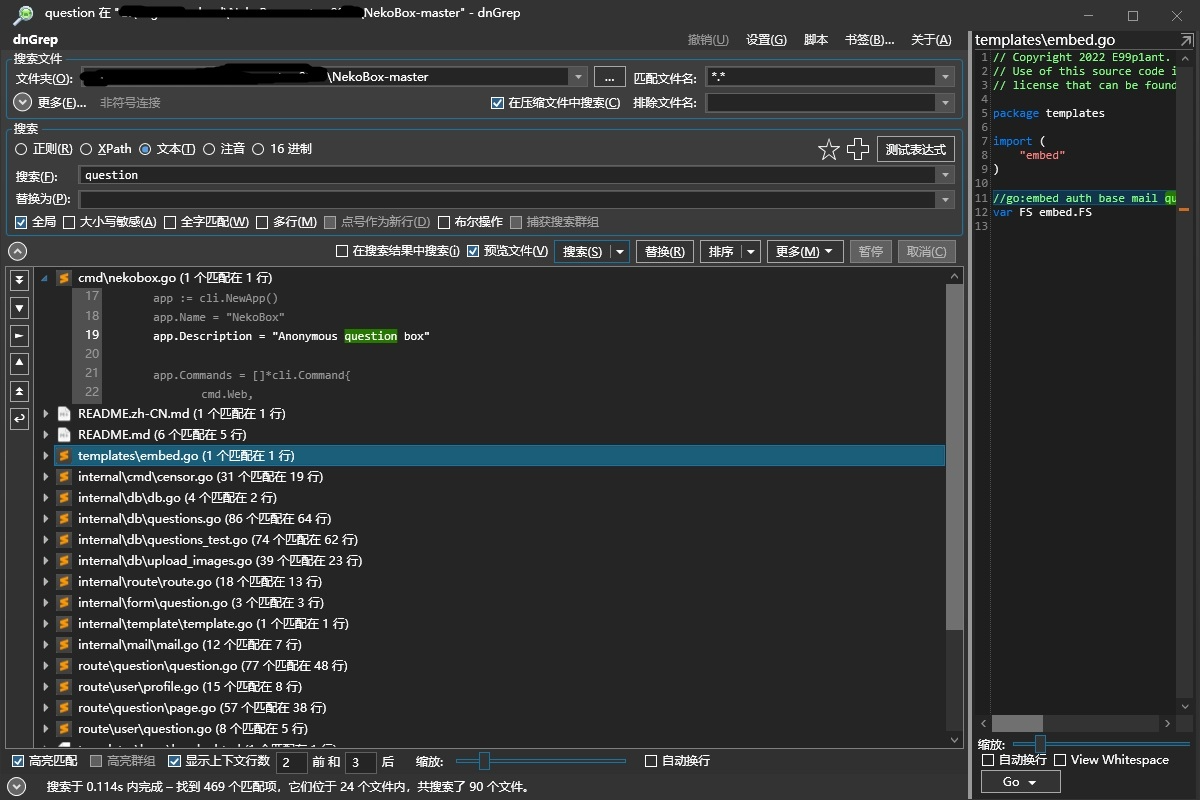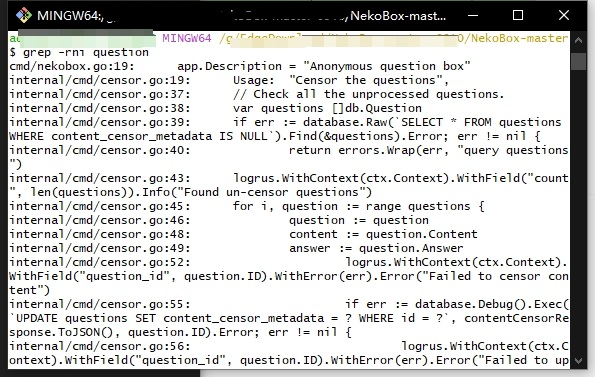grep 命令全名 global regular expression print(全局正则表达式打印),可以搜索一个或多个(输入)文件,以查找与「给定模式」相匹配的行,并将每个匹配行写入标准输出,这在Linux下是一个非常常用的命令。无论是筛选文件还是命令输出,基本上都是一个grep搞定。
但是Windows下就没有这么好用的东西(至少自带程序里面没有),只能通过装第三方软件实现,以下推荐几个我在使用的替代品:
GNU Grep
官网
Grep Windows 版 (sourceforge.net)
使用方法
到官网下载文件后安装,需要配置环境变量引导到Grep安装目录,然后即可在cmd或powershell中使用:
grep --help
Usage: grep [OPTION]... PATTERN [FILE]...
Search for PATTERN in each FILE or standard input.
PATTERN is, by default, a basic regular expression (BRE).
Example: grep -i 'hello world' menu.h main.c
Regexp selection and interpretation:
-E, --extended-regexp PATTERN is an extended regular expression (ERE)
-F, --fixed-strings PATTERN is a set of newline-separated fixed strings
-G, --basic-regexp PATTERN is a basic regular expression (BRE)
-P, --perl-regexp PATTERN is a Perl regular expression
-e, --regexp=PATTERN use PATTERN for matching
-f, --file=FILE obtain PATTERN from FILE
-i, --ignore-case ignore case distinctions
-w, --word-regexp force PATTERN to match only whole words
-x, --line-regexp force PATTERN to match only whole lines
-z, --null-data a data line ends in 0 byte, not newline
Miscellaneous:
-s, --no-messages suppress error messages
-v, --invert-match select non-matching lines
-V, --version print version information and exit
--help display this help and exit
--mmap use memory-mapped input if possible
Output control:
-m, --max-count=NUM stop after NUM matches
-b, --byte-offset print the byte offset with output lines
-n, --line-number print line number with output lines
--line-buffered flush output on every line
-H, --with-filename print the filename for each match
-h, --no-filename suppress the prefixing filename on output
--label=LABEL print LABEL as filename for standard input
-o, --only-matching show only the part of a line matching PATTERN
-q, --quiet, --silent suppress all normal output
--binary-files=TYPE assume that binary files are TYPE;
TYPE is `binary', `text', or `without-match'
-a, --text equivalent to --binary-files=text
-I equivalent to --binary-files=without-match
-d, --directories=ACTION how to handle directories;
ACTION is `read', `recurse', or `skip'
-D, --devices=ACTION how to handle devices, FIFOs and sockets;
ACTION is `read' or `skip'
-R, -r, --recursive equivalent to --directories=recurse
--include=FILE_PATTERN search only files that match FILE_PATTERN
--exclude=FILE_PATTERN skip files and directories matching FILE_PATTERN
--exclude-from=FILE skip files matching any file pattern from FILE
--exclude-dir=PATTERN directories that match PATTERN will be skipped.
-L, --files-without-match print only names of FILEs containing no match
-l, --files-with-matches print only names of FILEs containing matches
-c, --count print only a count of matching lines per FILE
-T, --initial-tab make tabs line up (if needed)
-Z, --null print 0 byte after FILE name
Context control:
-B, --before-context=NUM print NUM lines of leading context
-A, --after-context=NUM print NUM lines of trailing context
-C, --context=NUM print NUM lines of output context
-NUM same as --context=NUM
--color[=WHEN],
--colour[=WHEN] use markers to highlight the matching strings;
WHEN is `always', `never', or `auto'
-U, --binary do not strip CR characters at EOL (MSDOS)
-u, --unix-byte-offsets report offsets as if CRs were not there (MSDOS)
`egrep' means `grep -E'. `fgrep' means `grep -F'.
Direct invocation as either `egrep' or `fgrep' is deprecated.
With no FILE, or when FILE is -, read standard input. If less than two FILEs
are given, assume -h. Exit status is 0 if any line was selected, 1 otherwise;
if any error occurs and -q was not given, the exit status is 2.
Report bugs to: bug-grep@gnu.org
GNU Grep home page: <http://www.gnu.org/software/grep/>
General help using GNU software: <http://www.gnu.org/gethelp/>
netstat -a | grep localhost #通管筛选命令执行结果
TCP 127.0.0.1:5354 localhost:49718 ESTABLISHED
TCP 127.0.0.1:5354 localhost:49722 ESTABLISHED
...
grep -rin question * #遍历目录查询关键词位置
cmd/nekobox.go:19: app.Description = "Anonymous question box"
internal/cmd/censor.go:19: Usage: "Censor the questions",
internal/cmd/censor.go:37: // Check all the unprocessed questions.
...
优点
使用方法基本和Linux下一致
缺点
- 需要配置环境变量位置才能使用
- 最后一次更新已经是2009年了。
dnGrep
官网:dnGrep – 适用于 Windows 的强大搜索功能
这是一个GUI化的grep,能够实现使用文本、正则表达式、XPath等查询搜索文本文件、Word 和 Excel 文档、PDF 和存档。dnGrep 包括搜索和替换、整个文件预览、文件资源管理器中的右键单击搜索等等。
使用方法:到Github项目页面下载对应版本的安装包安装即可,项目自带中文,安装完成后可以到设置里面配置。使用方法也很简单,无非就是选择查找范围,选择搜索方式和搜索条件,搜索结果会高亮展现:

优点
- 图形化操作,更直观
- 搜索方式多样化
缺点
能搜文件,但只能搜文件。
对原生爱好者不友好。
Git-scm
其实这玩意就是个mingw64工具集,本来是用于git的,但是我看到他带bash和grep,安装使用也方便,就一直用了。
官网
使用方法
下载安装对应版本即可,也提供了便携版(PortableGit),解压即用。安装之后右键菜单会多出一个git bash,在指定目录下点开会进入一个bash终端,在这里就直接能执行grep了。

除了grep外,附带的其他命令可以在usr/bin/下看到。
优点
最真实的linux终端体验
缺点
如果只为了用grep的话有点为了这碗醋包饺子的感觉。